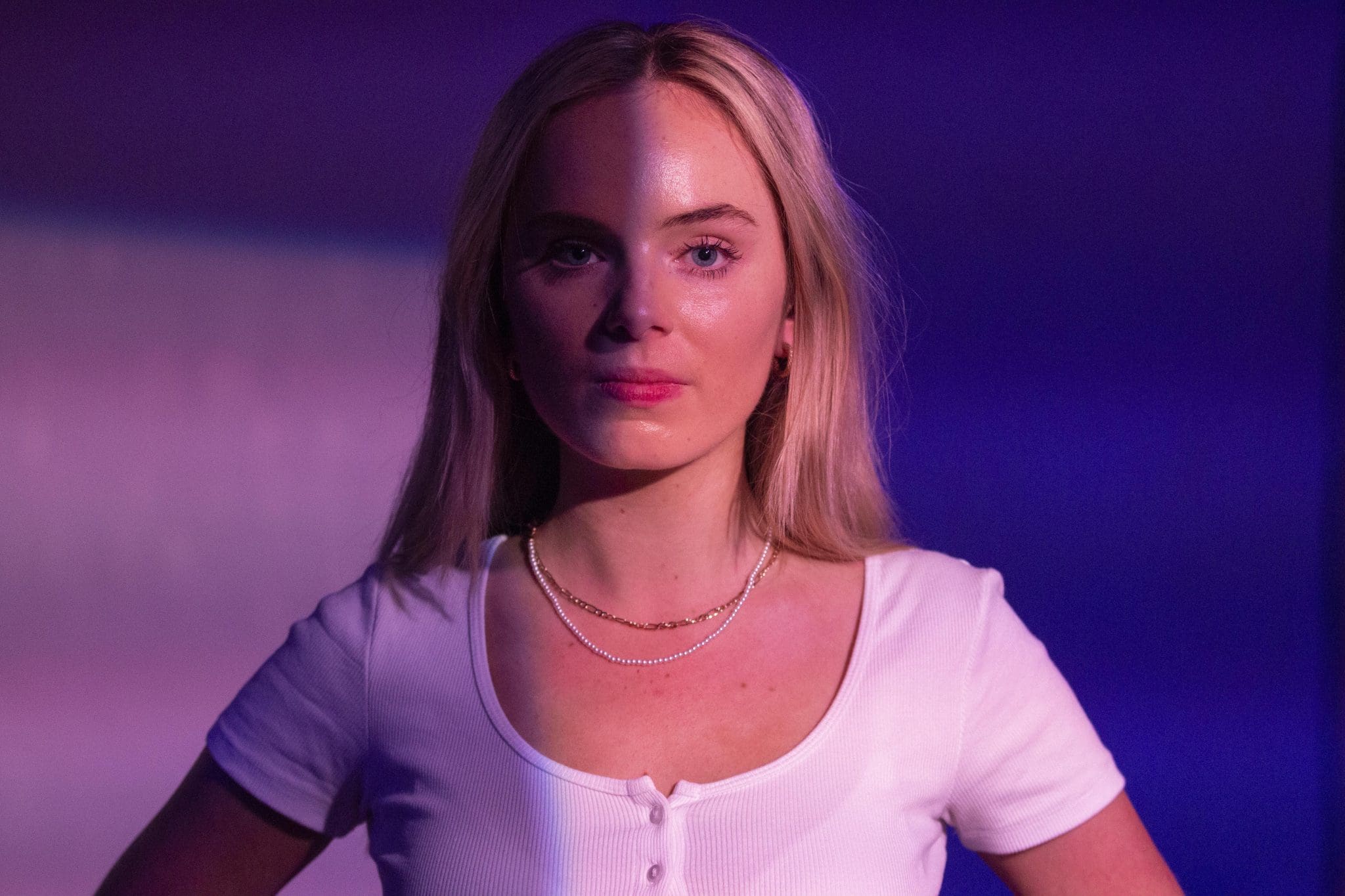CW: This article contains mentions of sexual violence and depression. This may be distressing for some readers.
Josephine Gazard’s That’s What She Said is the vulnerable story of a naive young woman failed by an institution built to protect society’s most privileged and her strength to persevere.
A blue and white striped jersey sits draped across a chair in the middle of King Cross Theatre’s ‘The Vault’. Our protagonist, Emily, played by Josephine Gazard, enters the stage and says “I’ve heard that the average male thinks about sex at least 19 times a day…..it must be much more than that”. Recently moved to Sydney from a regional town, Emily’s living at one of USyd’s infamous colleges. Her choice, St. Jude’s, known for its parties and drinking culture. She’s having the time of her life, having barely thought about the classes she’s enrolled in as she’s spent the last weeks either drunk or hungover. Today, she’s heading to class. $8 oat milk latte in hand, college jersey draped her shoulders, where she meets one the “third year boys”. An Arts/ Law student, who’s going to be a lawyer, just like the many men in his family who came before him. An awkward encounter in her room, followed by night of hazing alters Emily’s life forever.
With expert use of production elements, we’re effortlessly brought into the world of college life that Emily inhabits. The set comprising only of the chair occasionally moved across the stage throughout and her costume, a white top, jeans, birkenstocks and college jersey, made her unrecognisable from the many young people mulling about USyd’s campus or purchasing oat milk lattes at Ralph’s Cafe. A handful of separate lighting states and sound cues were employed to communicate shifts in location and evoke certain sensory experiences, perfecting supporting Gazard’s expertly crafted script. Sound in particular was utilised to bring the audience into Emily’s point of view, showcasing what she heard as her eyes were closed.
We follow Emily as she processes this immense trauma, seeing her undergo a series of invasive medical procedures at a Sexual Assault clinic and become increasingly detached from her friends and family. When she’s asked her address at the clinic, she responds, “I live at college”. They’re silent — they’ve seen girls from there before. As Emily struggles to come to terms with what she’s experienced, Gazard seamlessly communicates the feeling of utter disconnection. Her body feels like it is not hers, contaminated, yet she remains trapped within it, and she lives day to day riddled with doubt and self-disgust, thinking herself unworthy of basic acts of hygiene and self-care. Despite this, Emily persists, speaks out to the college and is once again disappointed as they seek to convince her of the fallibility of her subjective experience. This scene highlights the insidiousness of trauma of this type, how it manifests in the emotional, rendering itself difficult to communicate to those external. The title, That’s What She Said, speaks to this isolation and how it is weaponised to silence those victim to it. As the play came to a close, I looked around the audience to see tears filling the eyes of many in the room.
Gazard’s depiction of this story should be understood as nothing short of immense bravery. When understood in reference with other artistic works dealing in a similar subject matter, such as Diana Reid’s Love & Virtue, That What She Said contributes to an emerging canon of work which dissects these layers of power and privilege within institutions that condone behaviour of this kind and perpetuate cycles of abuse. Watching this performance, I’m reminded of the strength of art, not only as a mode of healing, but of consciousness-raising. With works like That’s What She Said, we can unlearn conditions we’ve been taught to accept and begin to conceive of a society without the prevalence of sexual assault. I’m reminded of Eve Ensler’s words, writer of the grounding play The Vagina Monologues; “I think of the security of cages. How violence, cruelty, oppression, become a kind of home, a familiar pattern, a cage, in which we know how to operate and define ourselves…”. We must identify this cage to break it. I thank Gazard and her team for doing just that.
If this article has caused you any distress you can contact any of the following organisations for assistance:
- The University’s Safer Communities student liaison officers, safer-communities.officer@sydney.edu.au or +61 2 8627 6808 (Monday to Friday, 8.30am – 5.30pm). After hours support through 1800 SYD HLP (1800 793 457) option 2.
- Free counselling through RPA Sexual Assault Clinic, 9515 9040 (Monday to Friday, 8:30am – 5:00pm). After hours 9515 6111. You can contact the Safer Communities Office if you are a student for priority access.
- NSW Sexual Violence Hotline, 1800 424 017 (24hrs, 7 days)
- 1800RESPECT on 1800 737 732.





